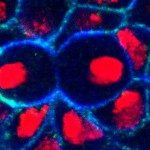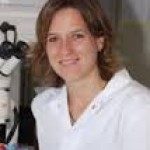Link to HAL – sorbonne-universite-01545567
Link to DOI – 10.1126/science.aai7407
Science, 2017, 356 (6337), pp.eaai7407. ⟨10.1126/science.aai7407⟩
INTRODUCTION: Spatial patterning in developing multicellular organisms relies on positional cues and cell-cell interactions. Stereotyped sensory organ arrangements in Drosophila are commonly attributed to a prepattern that defines regions of neural competence. Notch-mediated interactions then isolate sensory organ precursor (SOP) cells from among the competent cells. In support of this view, prepattern factors direct the expression of proneural factors in discrete clusters and determine the location of large bristles on the dorsal thorax. However, no such prepattern is known to establish the proneural stripes that give rise to finer-bristle rows. RATIONALE: By analogy with reaction-diffusion systems, we wondered whether Notch-mediated cell-cell interactions might organize a pattern of proneural stripes. To explore a possible role for Notch in proneural patterning, we generated fluorescent reporters for the proneural factors Achaete and Scute, the ligand Delta, and the Notch early-response factor E(spl)m3-HLH, which antagonizes proneural activity. We observed expression of these reporters in live and fixed samples throughout early pupal development. In parallel, we developed a mathematical model for Notch-mediated patterning. In this abstract model, the dynamics of a cell is expressed in terms of just two variables, for the state of the cell and the level of signal it receives. The model incorporates a series of plausible assumptions that govern its patterning behavior: Cells, which adopt the SOP fate in the absence of signal and the alternative, epidermal fate under high enough signal, exhibit a bistable response under intermediate signal levels. Inhibitory signaling from a cell varies nonlinearly with cell state and reaches beyond immediate neighbors. RESULTS: Before the onset of proneural gene expression, a bimodal gradient of Delta expression drove Notch activity; as a result of cis-inhibition, Notch was activated only in regions of intermediate Delta levels. This defined an inhibitory template for a first series of three proneural stripes. The spatial pattern of Notch activity dynamically changed as these first proneural stripes emerged, forming a negative template for a second group of intercalating stripes. Eventually, each stripe resolved into a row of isolated SOPs through Notch signaling. Thus, Notch mediated both proneural stripe patterning and SOP selection via a self-organized process. Simulations of the model, with a time-dependent inhibitory gradient describing the proneural-independent signaling seen in vivo, recapitulated the sequential emergence and resolution of proneural stripes. In both model and experiments, mutual inhibition drove a gradual refinement of the proneural group, concomitant with the buildup of proneural activity. Cells on the sides of the stripes were excluded first, such that stripes narrowed before isolated SOPs emerged. In terms of the model, cell-intrinsic bistability allowed cells with higher proneural activity, at the center of the stripes, to evade levels of inhibition that were sufficient to exclude cells on the sides. Nonlinear signaling allowed a smooth transition from weak mutual inhibition within an extended proneural group to strong lateral inhibition from emerging SOPs, ensuring that attrition of the proneural group proceeds until only isolated cells remain. Finally, the model correctly predicted the outcome of perturbation experiments affecting the pattern of Notch activity, the level and activity of Delta, and the range of signaling. CONCLUSION:Our results show that self-organized Notch signaling can establish stripe and dot patterns on a tissue-wide scale. A transient spatial bias, mediated by an initial gradient of Delta, is transduced by cell-cell interactions to produce a finer pattern of proneural stripes and bristle rows. Input from extrinsic positional cues and self-organization, sometimes considered competing paradigms for fate patterning, combine during bristle development and operate through the same signal. Self-organized Notch dynamics may provide a flexible substrate to generate diverse patterns in response to varying inputs.

